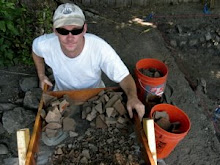------------------------------------------------------------------
Social Science Brown Bag Lecture Series: Louise Dyble
"Landmark of Death: Responsibility, Safety, and the Question of a Suicide Barrier on the Golden Gate Bridge."
Friday, March 26th, 12 Noon - 1 PM. Room AOB 201.
------------------------------------------------------------------
T. Allan Comp visit and lectures, March 28-29, 2010
Biography:
Dr T. Allan Comp is an historian based in Washington, DC. Jo Hanson, the pioneering public artist in San Francisco, once described Allan as "a relaxed blend of John Muir, John Dewey and John the Baptist." He holds a Ph.D in history, worked for several years in cultural resources with the National Park Service, left that to work as a developer of historic properties and consultant to historic preservation projects, and then to work for a regional Heritage Area in western Pennsylvania where he invented AMD&ART. Always a volunteer for AMD&ART, his work attracted the attention of other watershed and community improvement projects in the Appalachian coal country and in the Western hard rock mining country as well. Winner of multiple awards in partnerships and planning, Allan now leads the OSM/VISTA Team and Brownfields Initiatives at the Office of Surface Mining in the U.S. Department of the Interior.
http://tacomp.info/
http://tacomp.info/
Coffee with Social Science grad students from Industrial Heritage and Archaeology and Environmental Policy.
Monday, March 29, 8:30-9:30, Annex Seminar Room
Monday March 29, 2010 3pm DOW 642
The term "sustainable" can be, and is, thrown around a lot, but what does it really mean? How are we as practicing professionals working in the environment to appropriately use the term? What are the realistic dimensions of "sustainable'? What part does public input, public understanding, public support play in sustainability?
I'd like to review a few projects that attempted a broader approach to sustainability and then turn to some of the lessons learned in those efforts, both for professional practice and the
language we use to describe that practice and for larger community-based perceptions of sustainability (or reality) as well.
One such example is the AMD & Art project (http://www.orionmagazine.org/index.php/articles/article/460/)
Evening Public Engagement: Community-driven design in Environmental Reclamation
Monday March 29, 2010 6:30pm MUB Alumni Lounge B
The public lecture will definitely focus primarily on AMD&ART. Dr. Comp will explore the co-dependence of the arts and sciences in environmental reclamation by introducing the community as the pivotal factor in adding sustainability to the process. The public lecture will also focus on a few other spin-off projects to establish the viability of the approach and then try to draw a few lessons learned. It will also include a short bit on a strong determined OSM/VISTA team of volunteers in Appalachia and the Western Hardrock. This will be followed by an open question and answer session in the form of a dialogue.
------------------------------------------------------------------
Social Science Brown Bag Lecture Series: Sean Gohman
"John M. Longyear's land holdings in the Gogebic Iron Range through the lens of Geographic Information Systems"
Friday, April 2nd, Noon-1 PM, room AOB 201.
------------------------------------------------------------------
Moulshri Joshi, visit and lectures, April 18-24.
During the week of April 18-24, the Social Sciences department and the Visiting Women and Minority Lecturer/Scholar Series will be hosting Moulshri Joshi, a New Delhi architect and industrial heritage practitioner who is best known for her firm's prize-winning design of the Indian memorial to the victims of the Bhopal industrial disaster.
Prof. Joshi will be available to participate in undergraduate classes and graduate seminars in environmental policy and industrial heritage management, and will meet with other interested groups across campus, to discuss current practices related to environmentally-sensitive planning as well as international industrial heritage policy – both celebratory and critical. The central event of her residency will be a campus-wide lecture (probably Tues evening April 20) on the Bhopal Disaster and current efforts in India to memorialize its victims. Prof. Joshi, though early in her career, has been an invited consultant in Japan and Europe to discuss these matters.
The websites listed below can give you more information about Prof. Joshi's architectural firm, 'Space Matters,' as well as descriptions of the Bhopal memorial and the many public controversies arising from it. [This note by email from Susan Martin]
http://www.spacematters.in/
http://bhopalmemorial.blogspot.com/
http://www.telegraphindia.com/1091204/jsp/nation/story_11819749.jsp
http://www.thehindu.com/thehindu/fline/fl2626/stories/20100101262603800.htm
Prof. Joshi will be available to participate in undergraduate classes and graduate seminars in environmental policy and industrial heritage management, and will meet with other interested groups across campus, to discuss current practices related to environmentally-sensitive planning as well as international industrial heritage policy – both celebratory and critical. The central event of her residency will be a campus-wide lecture (probably Tues evening April 20) on the Bhopal Disaster and current efforts in India to memorialize its victims. Prof. Joshi, though early in her career, has been an invited consultant in Japan and Europe to discuss these matters.
The websites listed below can give you more information about Prof. Joshi's architectural firm, 'Space Matters,' as well as descriptions of the Bhopal memorial and the many public controversies arising from it. [This note by email from Susan Martin]
http://www.spacematters.in/
http://bhopalmemorial.blogspot.com/
http://www.telegraphindia.com/1091204/jsp/nation/story_11819749.jsp
http://www.thehindu.com/thehindu/fline/fl2626/stories/20100101262603800.htm
